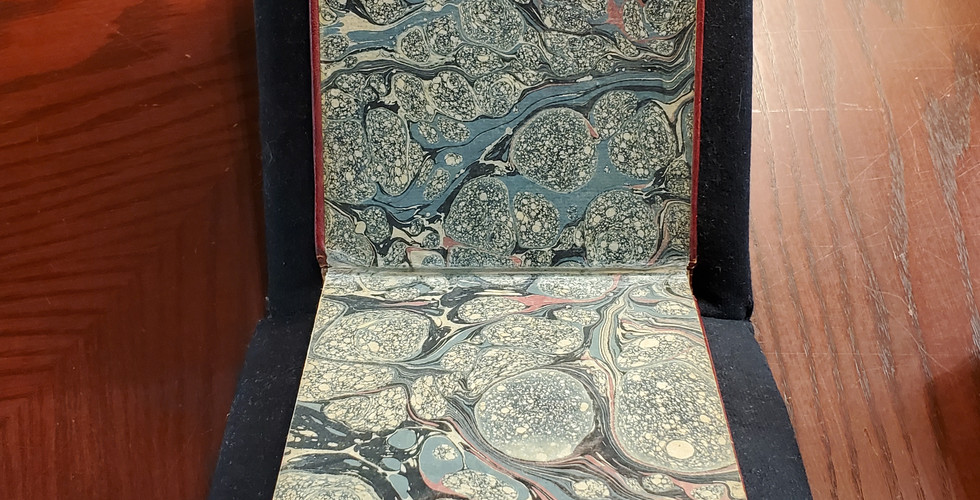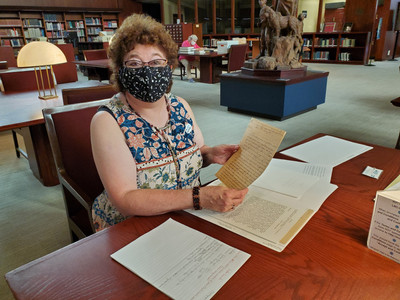BLOG: Research Heaven, Pt. 2--Documents pertaining to William and Julia Clark
- 1brookallen
- Dec 29, 2021
- 6 min read
For those of you patiently awaiting my book on Julia Hancock Clark, I do have some news. I completed my second draft yesterday, and it will go to my editor in May. So I have a lot more drafting left to do, but I’ve always considered that the fun part! Now it’s a matter of giving the historical details further perusal, adding more research that I’ve done since writing different sections, expanding scene dialogue, and adding or omitting material.
Over the past several years, I’ve blogged on research that I’ve done for the Antonius Trilogy and now I get to share tidbits about my new project. My latest research topic was the first of two on the incredible experience I had while visiting St. Louis and viewing artifacts from the Clark Family Collection at the Missouri Historical Society Library and Research Center. If you didn't get to read it, just scroll down on my blog page--it's waiting for you.
This week, I’d like to present some of the fantastic documents I read there, studied, and even held in my hands. As you look over these photos, you may be surprised that I’m not wearing rubber gloves. Archivist Molly Kodner did when handling William Clark’s elk-skin journal, which is as much an artifact as it is a priceless historical document. However, I was told that when it comes to antique documents, rubber gloves can cause some people to accidentally tear or ruffle pages more easily since it can inhibit one's sense of touch. Therefore, I handled these documents as carefully as I could—bare-handed.


First of all, the opportunity to visit and be led by an archivist through the viewing of historical documents is an honor, a privilege, and something never to be taken for granted. I was literally touching American history, and every second, I was conscious of that. I cannot thank the documents archivist Molly Kodner enough for her kindness and generosity in allowing me access to this collection, because it’s nothing short of phenomenal.
The Missouri Historical Society Library and Research Center is located inside a former Jewish synagogue (see above). The decoration and detail inside the research library is breathtakingly rich. There’s a feeling of peace and order within. Before entering, researchers are asked to place their belongings in a locker—certainly understandable. No ink-pens are allowed, but there are pencils provided for one’s convenience. Cell-phones are welcome, and I was taking photos like crazy! All of the documents I’d requested were placed on a table waiting for me when I walked in to find my place. And for the next three hours, I sat in research heaven—barely conscious of time passing when Molly politely came over to inquire if I was finished. Tempus fugit!
The very first item she shared with me has to be one of the most intriguing documents in the collection. When traveling overland to the Pacific with the Corps of Discovery, William Clark encased his field-journal within the hide of an elk. It’s known as the “elk-skin journal”, and it contains some of the first, rough-hewn cartography and sketches of lands west of the Missouri River, containing material dated from Sept. 11, 1805, to Dec. 31, 1805. It’s rather impressive that Clark was able to cram as much between these covers as he did, because it’s not a large volume, by any means. I asked Molly to put her hand down next to it to give my photograph a sense of its scale. This document/artifact is the only field-journal from the expedition to have survived.
And here I’ll add that Molly Kodner is herself a superb historian. In the next few months, I’ll be sharing some of her own research on Clark’s elk-skin journal, for nobody could possibly share its history more than the lady who handles it for researchers and students on school field-trips.
While I watched, Molly used a metal tool called a spatula to turn the delicate elk-skin journal’s pages for me to view. One of the highlights was a sketch of a map that Lewis and Clark made based on conversations with their Native American hosts to guide them to the Columbia River. (below, far left) When the Corps arrived on the Pacific Coast, they had to choose a site upon which to build their encampment, as they would spend the winter of 1805-06 there. Two separate spots were of interest, and they decided to take a vote. Remarkably, the elk-skin journal has the record of the voting process and Clark recorded each member of the Corps’ vote. (below, center) Two members of the expedition in particular stand out, as they were both given the right to cast a vote: Sacagawea, the Shoshone woman and Clark’s slave, York. If you enlarge the print, you'll see York's name along with "Janey"--Sacagawea's nickname on the top right of the right-hand page. The campsite they elected was named Fort Clatsop, after a native tribe inhabiting the coast. And on the back of the elk-skin journal—scribed upon the actual hide itself—is a crude drawing of the arrangement of the Corps’ quarters built at Fort Clatsop on what is now the Washington coast. (below, far right)
When William Clark began copying his Corps of Discovery journals into a neater product for future publishing, he favored plush red Moroccan journals, similar to the one below. The research center has four of these journals in its possession and some historians believe they may have been copied in the field, straight from the captains' well-seasoned (and probably dilapidated) field journals!
Julia Clark must have liked the red Moroccan journals, too, for she used at least one to record household inventories. I asked, and Molly confirmed that we may assume the handwriting within this journal to have belonged to Julia, herself. Below are photos arrayed in a slide show, so just click on the arrows. (Photo #1 is one of the red Moroccan journals belonging to Julia. Her name is on the front, and this particular one is dated to 1820, the same year she died. Photo #2 is the inside cover which I thought was particularly attractive. Photo #3 is one of Julia's household inventories, most probably in her own handwriting.)
On my visit, I discovered that William Clark had a graceful, showy signature. (see top photo) But his spelling was CRAZY! Webster's Dictionary wouldn't be published for years, and since I'm speaking to an educated audience-- try reading any of Clark's letters or journal entries, and you'll see what I mean!
Back in the early 19th century, letters were neatly folded INTO envelopes to be posted, once they were sealed in wax. There were not separate envelopes for letters to be placed in. This letter, addressed to William Clark from Meriwether Lewis still has some of the red wax seal sticking to the paper. I found it incredible that I was holding in my hand an actual letter sent from Lewis to Clark!!!

Also, note that the postmark indicates that Lewis sent it from Washington City—the early American name for what is now Washington DC. And the address shows that Clark was staying in Fincastle, Virginia at the Hancocks (at Santillane), courting Julia at the time. Look at the top right corner of the envelope and you'll see Meriwether Lewis's name in his own hand.
I’d like to share two final photos that my friends in Botetourt County, Virginia (where I live) will find especially interesting. In the photo below, I’m holding what is known as “Clark’s response to the people of Fincastle”—a document written by William Clark when he spoke at a celebration honoring his return from the Pacific, while he stayed at Santillane—home of Julia and the Hancock family. This gathering was held in Fincastle, which is still our County seat—probably near the location of today’s courthouse, though in 1806, the Fincastle courthouse was nothing more than a large log-lodge. A local Revolutionary War hero—Patrick Lockhart—spoke at the event, praising the entire Corps of Discovery for their courage, aplomb, and perseverance. Clark followed Lockhart’s words with the speech I’m holding. On the right, is a closer shot of the document itself.
When one is fascinated the way I am with history, research is never boring. History itself is vibrant and when you’re as close to it as I was on July 28th in St. Louis, assisted and guided by experienced professionals, Julia Clark’s world came alive for me, and for a few brief hours, I touched it and even held it in my hands. I only hope my own novel will present the same time-travel experience for my many readers as I enjoyed on that day. This author was so humbled by this entire experience.
If you haven't done so already, consider subscribing to this website so you'll receive my weekly blogs, guest-blogs, book-reviews, interviews, and updates. I only send one email out per week to avoid too much spam in my readers' mailboxes!
Read on, everybody!




















These are great! I've had the privilege to see the portrait and some of the journals in person and do research at the MHS, mostly relating to Lewis, Clark, and Frederick Bates. I'm excited to see what you find--and what you write. Lately I've been learning more about Letitia Breckinridge Gamble--and what did or didn't happen for Lewis. Tracking down portraits of Letitia as well as Robert Gamble from ca. 1808-1810 was fantastic. One of my direct ancestors, Robert Harvey, was James Breckinridge's business and political associate and friend. I enjoy your blog!
My husband and I just read your wonderful report on your investigation regarding the Clarks. We read the Marc Antony Trilogy and look forward to your new book. Sincerely, J Poisson
Very informative and so nicely presented with photos! Thanks, Margaret.